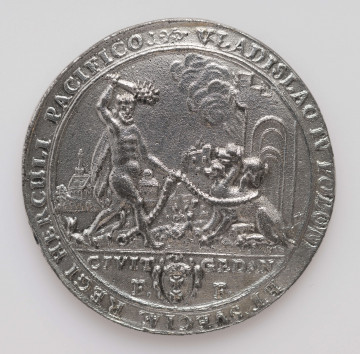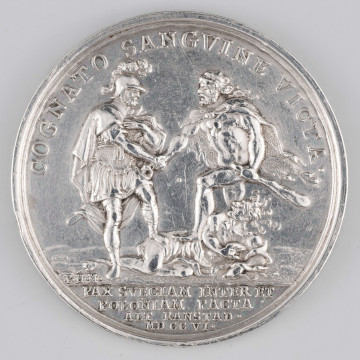
The wedding of Władysław IV with Cecilia Renata
1637
National Museum in Lublin
Part of the collection: Polish medallic art from the 16th to the 17th c.
Baroque was a crucial period in the history of Polish medal-making. One of the first representatives of the artistic trend in the Republic of Poland was Sebastian Dadler. His less than 15-year-long stay in Gdańsk, where he created, among others, for the Polish royal court, resulted in many outstanding works. An equally important achievement of Sebastian Dadler was the upbringing of his successor, who was Jan Höhn, called the Elder (as opposed to his son, also named Jan, called the Younger). Like Sebastian Dadler, Jan Höhn the Elder was born in Strasbourg, and after a peregrination around various European cities, he settled in Gdańsk. He came into contact with Dadler, becoming his co-worker, disciple, and finally, his successor, initially a co-author of works commissioned by Dadler. The period is well illustrated by medals on which the initials of both the senior master and the younger adept appear. At the same time Jan Höhn tried to develop his own individual style. He achieved full independence after 1647, when Sebastian Dadler left Gdańsk to settle permanently in Hamburg. Even after this period, however, Höhn often used his master's earlier designs. One of the first works created by Höhn after his arrival in Gdańsk was a medal commemorating the wedding of King Władysław IV Vasa and Cecilia Renata of the Habsburg dynasty. Interestingly, the medal was not commissioned by the royal court but was a kind of tribute paid to the royal couple by the city of Gdańsk. Particularly interesting is the obverse of the medal depicting Hercules drawing the three-headed dog Cerberus out of Hades. The surrounding inscription informs that King Władysław IV, the sower of peace, is depicted under the figure of Hercules. In order to fully understand the meaning of this scene, it must be remembered that it was also present on another medal by Johann Höhn, the Elder. It is a medal celebrating the King's military achievements, thanks to which we can see that the three-headed Cerberus is a personification of Russia, Turkey and Sweden, i.e. the countries which at that time posed the greatest threat to Poland. Unlike the obverse, the reverse is closely related to the occasion on which it was made. It shows two heraldic eagles - the Polish one with the Vasa coat of arms on the chest, and the imperial one with the Habsburg coat of arms, whose union was to bring benefits to both sides.
Leszek Poniewozik
Author / creator
Dimensions
cały obiekt: width: 47,5 mm
Object type
medal
Technique
stamp minting
Material
silver
Creation time / dating
Creation / finding place
Owner
The National Museum in Lublin
Identification number
Location / status

1637
National Museum in Lublin

1706
National Museum in Lublin

circa 1801 — 1810
National Museum in Szczecin
DISCOVER this TOPIC
Museum of King Jan III's Palace at Wilanów
DISCOVER this PATH
Educational path